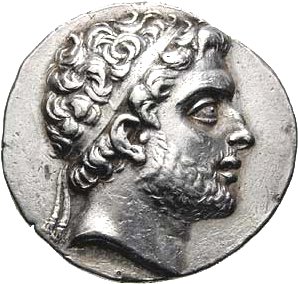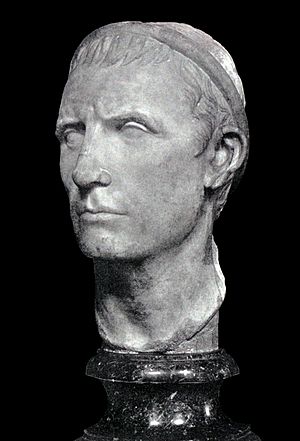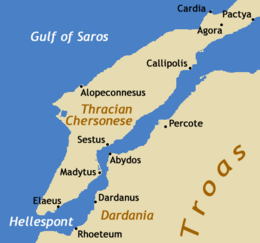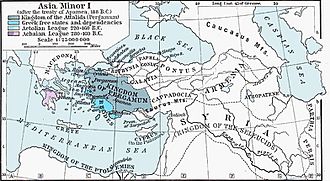Cretan War (205–200 BC) facts for kids
Quick facts for kids Cretan War |
|||||||||
|---|---|---|---|---|---|---|---|---|---|
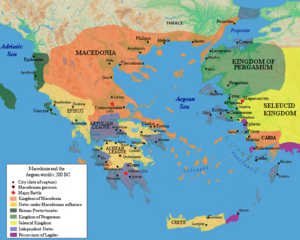 Greece and the Aegean c. 201 BC |
|||||||||
|
|||||||||
| Belligerents | |||||||||
| Macedonia, Hierapytna, Olous, Aetolia, Spartan pirates, Acarnania |
Rhodes, Pergamum, Byzantium, Cyzicus, Athens, Knossos |
||||||||
| Commanders and leaders | |||||||||
| Philip V, Dicaearchus, Nicanor the Elephant |
Attalus I, Theophiliscus † Cleonaeus |
||||||||
The Cretan War (205–200 BC) was a big fight in ancient times. It involved King Philip V of Macedon and his allies, like the Aetolian League and some cities on Crete. They fought against the powerful island of Rhodes and its friends. Later, other important places like Pergamum, Byzantium, Cyzicus, Athens, and Knossos joined Rhodes.
Philip V had just finished another war. He saw a chance to weaken Rhodes, which was a strong naval power. So, he teamed up with pirates from Aetolia and Sparta. These pirates started attacking Rhodian ships. Philip also made friends with Cretan cities like Hierapytna and Olous. He thought this would help him defeat Rhodes.
To make things even harder for Rhodes, Philip made a deal with Antiochus the Great, the king of the Seleucid Empire. They planned to attack Ptolemy V of Egypt, who was also an ally of Rhodes. Philip then started attacking lands that belonged to Ptolemy and Rhodes in places like Thrace.
In 202 BC, Rhodes and its allies combined their fleets. They won a big battle against Philip near Chios. But soon after, Philip's fleet defeated the Rhodians at the Battle of Lade. While Philip was busy attacking Pergamum, King Attalus I of Pergamum went to Athens. He convinced Athens to declare war on Philip.
Philip attacked Athens with his navy. But the Romans warned him to stop. After another defeat by the Rhodian and Pergamese fleets, Philip left. He still attacked the city of Abydos before leaving. The Romans then declared war on Philip. This left the Cretan cities without their main ally. So, Knossos, the biggest city on Crete, joined Rhodes. Hierapytna and Olous had to give up and sign a peace treaty that favored Rhodes.
Contents
Why the War Started: Philip's Big Plans
In 205 BC, the First Macedonian War ended. A treaty said that Macedon couldn't expand to the west. Rome was busy fighting Carthage at the time. Philip V saw this as a chance to control the Greek world. He knew that having allies on Crete would help him. So, he encouraged Cretans to attack Rhodian ships.
Philip had already defeated Pergamum, a strong Greek state in Asia Minor. He also made friends with Aetolia. Now, only Rhodes stood in his way. Rhodes was an island nation that controlled trade and the navy in the southeastern Mediterranean. Even though Rhodes was officially allied with Philip, it was also friends with Rome. Philip wanted to become the most powerful ruler in the Balkans. He defeated the Illyrians to secure his northern border. With that done, he could focus on the Aegean Sea.
Pirates and Early Battles: Trouble on the Seas
The peace treaty stopped Philip from expanding west. So, he looked east to the Aegean Sea. He started building a large navy. Philip had two ways to challenge Rhodes' control of the sea: piracy and war. He decided to use both. He encouraged his allies to become pirates and attack Rhodian ships.
Philip already had a connection to Crete from an earlier war. He convinced the Cretans, who were already known for piracy, to join. He also got the Aetolians and Spartans to help. The reward for them was lots of treasure from captured Rhodian ships. Philip sent a pirate named Dicaearchus to raid islands and Rhodian lands. Philip also tried to secretly damage Rhodes' navy. He sent an agent named Heracleides to Rhodes. Heracleides managed to burn 13 boat-sheds there.
By the end of 205 BC, Rhodes was weaker because of these pirate attacks. Philip decided it was time for direct war. He convinced Hierapytna, Olous, and other cities in eastern Crete to declare war on Rhodes. Rhodes first tried to get help from Rome. But the Romans had just finished a long war and didn't want another one. Even after Pergamum, Cyzicus, and Byzantium joined Rhodes, Rome still didn't want to fight.
Philip then attacked Cius, a city allied with Aetolia. This city was on the coast of the Sea of Marmara. Rhodes and other states tried to make peace, but Philip captured and destroyed Cius. He also destroyed a nearby city called Myrleia. Philip then gave these cities to his brother-in-law, King Prusias I of Bithynia. Prusias rebuilt them and renamed them Prusa and Apameia. In return, Prusias promised to keep fighting Pergamum. This angered the Aetolians, as Cius and Myrleia were part of their league. Philip also forced other Aetolian cities to leave the league.
On his way home, Philip's fleet stopped at the island of Thasos. Philip's general, Metrodorus, met with leaders from the city. The Thasians agreed to surrender if they didn't have to host soldiers, pay taxes, or send soldiers. They also wanted to keep their own laws. Metrodorus said Philip agreed. But once inside, Philip ordered his soldiers to capture and sell all the citizens as slaves. They also looted the city. Philip's actions made other Greek states see him as no better than savage raiders.
Around 204 BC, Philip was approached by ministers from young King Ptolemy V of Egypt. They wanted Philip's daughter to marry Ptolemy. This would create an alliance against Antiochus III the Great of the Seleucid Empire. Antiochus wanted to expand his empire into Egypt. But Philip said no. Instead, in 203–202 BC, Philip made a deal with Antiochus. They agreed to split up the Ptolemaic Empire. Philip would help Antiochus take Egypt and Cyprus. Antiochus would help Philip take control of Cyrene, the Cyclades, and Ionia.
In late 202 BC, the Aetolians sent messengers to Rome. They wanted an alliance against Philip. Philip's actions had made the Aetolian League feel unsafe. But the Romans refused to help. They were still upset that the Aetolians had made peace with Philip earlier. Rome's refusal encouraged Philip to continue his plans in the Aegean. Philip believed controlling the Aegean was key to his power. It would also help him keep Pergamum isolated and stop Rome from interfering in the eastern Mediterranean.
After making his deal with Antiochus, Philip's army attacked Ptolemy's lands in Thrace. When Philip heard that King Attalus I of Pergamum had joined Rhodes, he became very angry. He invaded Pergamum's territory. Attalus had prepared his capital's walls before sailing to fight Philip's navy. He hoped to stop Philip from taking much treasure. Philip attacked the city, but its walls were too strong. He retreated after destroying some temples.
After leaving Pergamum, Philip's fleet sailed south. He took the island of Samos from Ptolemy V. He also captured the Egyptian fleet there. The fleet then went north and attacked the island of Chios. Philip wanted to use these northern islands as stepping stones to reach Rhodes. The attack on Chios wasn't going well. The combined fleets of Pergamum, Rhodes, and their new allies, Kos, Cyzicus, and Byzantium, were approaching. Philip realized they were trying to trap him. He stopped the attack and tried to sail to a friendly harbor. But the allied fleet met him, leading to the Battle of Chios.
Philip's fleet had about 200 ships and 30,000 men. The allied fleet was much smaller, with 65 large warships and a few smaller ones. The battle began with Attalus, leading the allied left side, attacking Philip's right. The Rhodian admiral Theophiliscus led the allied right side against Philip's left. The allies gained an advantage on their left side. They captured Philip's main ship, and Philip's admiral was killed. On the other side, the Macedonians pushed the Rhodians back at first. Theophiliscus was badly wounded but managed to rally his men. The Rhodians used their excellent sailing skills to damage many Macedonian ships. This turned the battle in their favor.
On the allied left, Attalus saw one of his ships sinking. He sailed to help with two ships and his flagship. Philip, whose ship hadn't been in the fight yet, saw Attalus separated from his fleet. Philip attacked Attalus with four large warships. Attalus got scared and ran his ships onto the shore. He threw coins and valuable clothes onto his ship's deck. Then he fled to the city of Erythrae. When the Macedonians arrived, they stopped to collect the treasure. Philip thought Attalus had died. He started towing away Attalus's flagship.
After their king fled, the Pergamese fleet went north. The Macedonian left side, beaten by the Rhodians, retreated to join their winning right side. This allowed the Rhodians to sail safely back to Chios. The battle was a big loss for Philip. He lost 92 ships and had 7 captured. The allies lost fewer ships. Philip lost 6,000 rowers and 3,000 soldiers, with 2,000 captured. The allies had much fewer casualties. This defeat was very costly for Philip.
After the battle, the Rhodian admirals decided to sail home. On the way, Admiral Theophiliscus died from his wounds. He chose Cleonaeus to take his place. As the Rhodian fleet sailed near Miletus, Philip's fleet attacked them. Philip defeated the Rhodian fleet in the Battle of Lade. The Rhodians had to retreat back to Rhodes. The people of Miletus were impressed by Philip's victory. They sent him gifts when he entered their land.
Asia Minor Campaign: Raids and Escapes
Philip was disappointed with the treasure he found in Mysia. He went south and looted towns in Caria. He attacked Prinassus, which fought bravely at first. But when Philip brought his siege weapons, he offered them a choice. They could leave unharmed or be killed. The citizens decided to leave. At this point, Philip's army was running out of food. He took the city of Myus and gave it to the Magnesians for food. Since the Magnesians had no grain, Philip took figs instead. Then, Philip quickly captured and put soldiers in the cities of Iasos, Bargylia, Euromus, and Pedasa.
While Philip's fleet was spending the winter in Bargylia, the combined Pergamese and Rhodian fleet blocked the harbor. The Macedonians were close to giving up. Supplies sent by Zeuxis helped a little. But Philip managed to escape using a trick. He sent an Egyptian deserter to Attalus and the Rhodians. The deserter said Philip was planning to attack them the next day. Attalus and the Rhodians started preparing their fleet for the attack. While they were busy, Philip secretly sailed past them at night. He left many campfires burning to make it look like he was still there.
While Philip was fighting, his allies, the Acarnanians, started a war with Athens. This happened after Athenians killed two Acarnanian athletes. The Acarnanians complained to Philip. He sent a force led by Nicanor the Elephant to help them attack Attica. The Macedonians and their allies looted Attica. They reached the Academy of Athens. But Roman ambassadors in the city ordered them to leave or face war with Rome.
Philip's fleet had just escaped the blockade. Philip ordered a group of ships to go to Athens. The Macedonian ships sailed into Piraeus and captured four Athenian ships. As they were leaving, the Rhodian and Pergamese fleet appeared. They had followed Philip's ships across the Aegean. They attacked the Macedonians and won. They got the Athenian ships back and returned them to Athens. The Athenians were so happy that they honored Attalus. They also destroyed monuments to Macedonian kings. Attalus and the Rhodians convinced Athens to declare war on Macedon.
The Pergamese fleet went back to its base. The Rhodians set out to conquer all Macedonian islands from Aegina to Rhodes. They succeeded in taking all of them except Andros, Paros, and Cythnos. Philip ordered his commander on Euboea, Philoces, to attack Athens again. Philocles had 2,000 foot soldiers and 200 horsemen. He couldn't capture Athens, but he destroyed the countryside around it.
Roman Intervention: Rome Steps In
Meanwhile, groups from Rhodes, Pergamum, Egypt, anti-Macedonian Crete, and Athens went to Rome. They spoke to the Roman Senate. They told the Senate about the treaty between Philip and Antiochus. They also complained about Philip's attacks. The Romans sent three ambassadors to Egypt. They were told to go to Rhodes after talking with Ptolemy.
While this was happening, Philip attacked and took cities in Thrace that still belonged to Ptolemy. These included Maroneia and Cypsela. The Macedonians then moved into the Thracian Chersonese. They captured cities like Perinthus and Sestos. Philip then went to the city of Abydos. This city was held by soldiers from Pergamum and Rhodes. Philip began to attack the city. He blocked it by land and sea to stop supplies or help from reaching it. The people of Abydos fought bravely. They used their own catapults to damage Philip's siege machines. Some of Philip's machines were burned. When their siege weapons were ruined, the Macedonians started digging tunnels under the city walls. They eventually made the outer wall collapse.
The situation was very bad for the defenders. They sent two important citizens to talk to Philip. They offered to surrender the city. They asked that the Rhodian and Pergamese soldiers be allowed to leave safely. They also asked that all citizens be allowed to leave with their clothes and go wherever they wanted. This basically meant giving up completely. Philip replied that they should "surrender completely or fight like men." The ambassadors had no choice but to take this message back to the city.
The city leaders heard Philip's answer. They decided to free all slaves to ensure their loyalty. They put all children and their nurses in the gymnasium. All women were placed in the temple of Artemis. They also asked everyone to bring their gold, silver, and valuable clothes. These would be put on the Rhodian and Cyzicene boats. Fifty trusted older men were chosen to do these tasks. Then, all the citizens took an oath. As the historian Polybius wrote:
... whenever they saw the inner wall being captured by the enemy, they would kill the children and women, and would burn the above mentioned ships, and, in accordance with the curses that had been invoked, would throw the silver and gold into the sea.
After taking the oath, they brought forward the priests. Everyone swore they would defeat the enemy or die trying. When the inner wall fell, the men fought very bravely. Philip had to send his troops forward in waves. By nightfall, the Macedonians went back to their camp. That night, the people of Abydos decided to save the women and children. At daybreak, they sent priests and priestesses with a garland to the Macedonians. They surrendered the city to Philip.
Meanwhile, Attalus sailed to the island of Tenedos. The youngest Roman ambassador, Marcus Aemilius Lepidus, heard about the attack on Abydos while in Rhodes. He arrived at Abydos to find Philip. Meeting the king outside the city, Lepidus told him what the Roman Senate wanted. Polybius wrote:
The Senate had resolved to order him not to wage war with any Greek state; nor to interfere in the dominions of Ptolemy; and to submit the injuries inflicted on Attalus and the Rhodians to arbitration; and that if he did so he might have peace, but if he refused to obey he would promptly have war with Rome." Upon Philip endeavoring to show that the Rhodians had been the first to lay hands on him, Marcus interrupted him by saying: "But what about the Athenians? And what about the Cianians? And what about the Abydenians at this moment? Did any one of them also lay hands on you first?" The king, at a loss for a reply, said: "I pardon the offensive haughtiness of your manners for three reasons: first, because you are a young man and inexperienced in affairs; secondly, because you are the handsomest man of your time" (this was true); "and thirdly, because you are a Roman. But for my part, my first demand to the Romans is that they should not break their treaties or go to war with me; but if they do, I shall defend myself as courageously as I can, appealing to the gods to defend my cause.
Philip then ordered another attack on Athens. His army failed to take Athens or Eleusis. But they destroyed the countryside around Attica, worse than it had been since the Persian Wars. Because of this, the Romans declared war on Philip. They invaded his lands in Illyria. Philip had to stop his fight against Rhodes and Pergamum. He needed to deal with the Romans and the situation in Greece. This started the Second Macedonian War.
After Philip left, the Rhodians were free to attack Olous and Hierapytna. They also attacked other Cretan allies of Philip. Rhodes found more allies on Crete when Knossos, a major Cretan city, saw that Rhodes was winning. Knossos joined Rhodes to gain power over the island. Many other cities in central Crete then joined Rhodes and Knossos against Hierapytna and Olous. Hierapytna was attacked from two sides and surrendered.
Aftermath: What Happened Next
After the war, Hierapytna agreed to end all alliances with other powers. It also had to let Rhodes use all its harbors and bases. Olous also had to accept Rhodes' control. So, Rhodes gained control of a large part of eastern Crete after the war. This allowed the Rhodians to help their allies in the Second Macedonian War.
The war didn't change much for the rest of Crete right away. Pirates and mercenaries there continued their old jobs. Three years later, in the Battle of Cynoscephalae during the Second Macedonian War, Cretan archers fought for both the Romans and the Macedonians.
The war was very costly for Philip and Macedon. They lost a fleet that took three years to build. Their Greek allies, the Achean League and the Aetolian League, also switched sides to the Romans. Right after the war, a barbarian tribe called the Dardani attacked Macedon from the north. Philip managed to push them back. But in 197 BC, Philip was defeated by the Romans at the Battle of Cynoscephalae. He had to give up most of his land outside Macedon. He also had to pay a huge amount of silver to the Romans.
The Rhodians regained control over the Cyclades islands. They also confirmed their strong naval power in the Aegean. Rhodes' control of eastern Crete helped them stop piracy in that area. But pirate attacks on Rhodian ships continued. This eventually led to the Second Cretan War. Attalus died in 197 BC. His son, Eumenes II, became king. He continued his father's policy of opposing Macedon. Pergamum gained several Aegean islands that Philip had owned. They became the most powerful state in Asia Minor, with only Antiochus as a rival.


